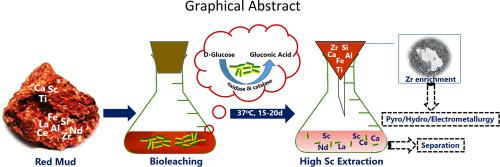Hydrometallurgy ( IF 4.7 ) Pub Date : 2021-05-04 , DOI: 10.1016/j.hydromet.2021.105621 Abhilash , Sabrina Hedrich , Axel Schippers

|
The aim was to study bioleaching of rare earth elements from red mud by a chemoorganotrophic microorganism, and to investigate the microbe-mineral interactions. Red mud is a promising resource for scandium, whose concentration was 92 and 54 mg/kg in two samples from Germany and India, respectively; however, both showed appreciably high concentration of zirconium. A gluconic acid-producing bacterium, Gluconobacter oxydans (DSMZ 46616), was used in the bioleaching experiments under parametric variation of inoculum concentration, pulp density, and culture adaptation. At a solid load of 10% (w/v) red mud with 10% (v/v) bacterial inoculum at 37 °C, a maximum solubilisation of 83% and 94% Sc was observed after 18–20 d of incubation for Indian and German red mud, respectively. The total amount of gluconic acid excreted by the bacteria increased with an increase in pulp density up to 10% (w/v). After bioleaching, SEM-EDAX analysis of the solid residue depicted enrichment of zirconium associated with the silicate matrix, and the bacterial cells were adhered to the major mineral matrix.
中文翻译:

red在红泥中的分布和使用氧化葡糖杆菌提取
目的是研究化学有机营养微生物从赤泥中生物浸出稀土元素,并研究微生物与矿物之间的相互作用。赤泥是for的一种有前途的资源,在两个来自德国和印度的样品中,mud的浓度分别为92和54 mg / kg。然而,两者均显示出相当高的锆浓度。在接种浓度,果肉密度和培养适应性的参数变化下,一种产葡萄糖酸的细菌,氧化葡糖杆菌(DSMZ 46616)被用于生物浸出实验中。固含量为10%(w / v)的赤泥和10%(v/ v)在37°C的细菌接种液中,分别在印度和德国赤泥培养18–20 d后观察到最大溶解度分别为83%和94%Sc。细菌排出的葡萄糖酸总量随着果肉密度的增加而增加,最高可达10%(w / v)。生物浸出后,固体残留物的SEM-EDAX分析表明与硅酸盐基质相关的锆的富集,细菌细胞粘附在主要的矿物基质上。


























 京公网安备 11010802027423号
京公网安备 11010802027423号